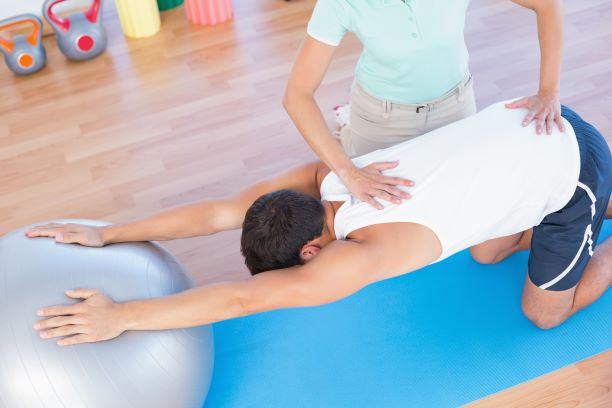According to recent research, nearly 1 in 4 people experience upper back pain each year. At some point, most of us have felt pain between our shoulder blades or across the back of our shoulders. Upper back pain can be coming from your joints, discs, or muscles. A rounded shoulder posture is a common contributor to upper back pain. This article shows you 6 postural exercises to help with upper back pain.

A rounded shoulder posture is common in people who sit for prolonged periods. This is especially the case for people who work on a laptop or tablet. Holding your head down when you work exacerbates a rounded shoulder posture. Also, many people with this posture have trouble holding their heads up when they walk. Exercise is most effective when combined with frequent postural changes throughout the day. Move it or lose it!
Exercise is Proven to Help Poor Posture
A large research paper out of Canada investigated the benefits of exercise for improving upper back posture. Researchers looked at 13 different studies. They were interested in how exercise influences age-related hyper-kyphosis. Kyphosis refers to the normal natural curvature in your upper back. With age-related changes and a sedentary lifestyle, this curvature worsens. Increased kyphosis is linked to upper back pain.
Most studies showed a benefit to exercise in reducing the angle of kyphosis. In other words, exercise improves rounded shoulder posture. Spinal extension exercises and some forms of yoga are most beneficial for improving posture.
This article shows 3 simple stretches you can perform in your own home. More importantly, the 3 strengthening exercises performed regularly will result in the greatest improvements in pain.
Stretching Exercises for Upper Back Pain
Have you ever noticed how often you look down during your day? You look down when you work on your computer. You look down when washing your dishes. And you probably look down most of the time when you walk. Your upper back is going to follow the lead of your head. When your head drops, your shoulders round, and your upper back flexes. Stretching exercises will help.
It is important to improve the flexibility of your thoracic spine and the muscles of your chest and shoulders. In particular, you will benefit from performing thoracic spine extension exercises. A foam roll is helpful for these stretches. An exercise ball or chair helps stretch your lat muscles. All you need to stretch your pec muscles is a wall or door frame.
Tightness in your lats and pecs pulls your shoulders forward. Stretch these muscles daily. Perform 2 to 3 stretches each time. Hold each stretch for 20 to 30 seconds.
Strengthening Exercises for Upper Back Pain
Stretch the muscles that pull your shoulders forward. And strengthen the muscles that pull your shoulders and spine back. These muscles are found along your spine and between your shoulder blades. It is best to perform exercises in a face-down position. This works your muscles against gravity. It also keeps your spine in an extended position.
Remember, you want to improve your spine extension strength and pull your shoulders back.
Perform these exercises daily. We recommend a minimum of 3 days per week. They are intended to be done without any weights. But if they are feeling easy you can hold light dumbbells. Proper form and building endurance are more important than adding weights. Start with 2 sets of 10 to 15 reps. Work towards 20 to 30 reps per set.
Include Abdominal Strengthening Exercises
Believe it or not, the function of your abdominal muscles plays a role in your upper back posture. Weak abdominals cause postural changes in your pelvis and lower back. To compensate for these changes below, your upper back must be round. Strengthening only your upper back muscles will result in only partial pain relief. Try working on a couple of the abdominal exercises described here.
How to Start Exercising with Upper Back Pain
These 6 exercises are proven to ease your upper back pain. They are a sample of many effective options. You will also benefit from receiving manual therapy performed by your physical therapist. As always, your unique situation and goals dictate the approach that is best for you. Improvements will be small at first but stick with it. Commit to these exercises for at least 6 weeks.
If you want help getting started, call our office to schedule an initial evaluation with your physical therapist.


